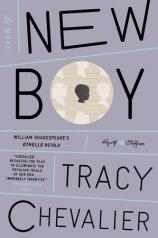New Boy
Review
New Boy
Over the past couple of years, I’ve really enjoyed reading entries in the Hogarth Shakespeare series, which challenges award-winning novelists to reimagine famous Shakespeare plays in novel form. Margaret Atwood, Jeanette Winterson, Anne Tyler and Howard Jacobson have all tried their hand at this ambitious project; now it’s the turn of Tracy Chevalier, best known as the author of GIRL WITH A PEARL EARRING. Chevalier’s assignment is Shakespeare’s tragedy, “Othello.”
In Chevalier’s version, the tragic events of the story play out over a single day --- and yes, “play” is the correct term, because the setting for most of the action is the playground of an elementary school. It’s the 1970s in suburban Washington, DC, at a school with only white students. That is, until Osei Kokote joins the fifth grade. The son of a diplomat, Osei is originally from Ghana but has lived in several different cities around the world, including exotic and vaguely dangerous New York City. Now Osei (or “O,” he suggests, when his new classmates can’t quite pronounce his name) has been assigned to finish out the waning school year in his new school district, just before all the kids in his grade advance to middle school in the fall.
"Chevalier’s novel does an admirable job of prompting readers to look backwards, to Shakespeare’s original material, and forward, to the lessons that 1970s-era school children might still teach us about the state of race relations in the US today."
As the “new boy,” Osei is forced to contend with years worth of jealousies, betrayals and power struggles, dynamics that he recognizes immediately even if he doesn’t know the history behind them. To most of the students, he is interesting primarily by virtue of his newness, his difference, his otherness, but beautiful Daniela (known as Dee) seems to see him for himself. When Osei endears himself to Dee, giving her the strawberry pencil case he got from his older sister, and when he makes a name for himself immediately on the kickball field, he begins to draw less welcome attention, namely from Ian. Ian is a schemer and a conniver, and he’s bound and determined to keep Osei from finding comfort, success or love.
Translating “Othello” from the stage to the page means that some of the play’s peculiarities and inconsistencies seem even more unlikely in novel form. Ian’s motivations, for example (like his predecessor Iago’s), are never quite adequately explained, and the pencil case (which stands in for the original’s handkerchief) soon takes on a significance quite out of proportion to reality.
That said, Chevalier has chosen her setting and subject well; this 1970s suburban school is on the cusp of change of all sorts. The children are about to leave the comfortable schoolyard with its jungle gyms and Double Dutch for the much more dangerous landscape of middle school, with all its social and sexual tension. And the uncomfortable integration of Osei into the predominantly white classroom offers plenty of opportunity to explore issues of race and prejudice in America, both historically and more contemporarily.
If NEW BOY has a fault, it’s that its schoolyard setting means that, by necessity, the stakes are lower for its characters than they were in "Othello." Nevertheless, though, Chevalier’s novel does an admirable job of prompting readers to look backwards, to Shakespeare’s original material, and forward, to the lessons that 1970s-era school children might still teach us about the state of race relations in the US today.
Reviewed by Norah Piehl on May 19, 2017
New Boy
- Publication Date: February 13, 2018
- Genres: Fiction
- Paperback: 224 pages
- Publisher: Hogarth
- ISBN-10: 0553447653
- ISBN-13: 9780553447651





